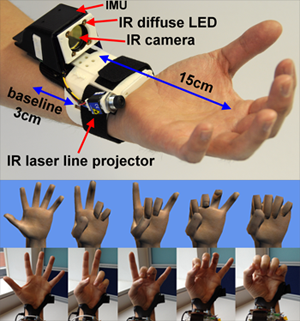 NEWS
NEWS
 NEWS
NEWS
 NEWS
NEWS
![]() One of the challenges with augmented reality and human computer interaction is having a wearable computer connect with the human—for most mobile phones this is a tiny keyboard, a bunch of buttons, or a touch screen. However, with innovations such as Google Glass bringing the display from the hands and directly into the eyes, this means that interacting with a mobile device could become cumbersome. Enter Microsoft offering a potential solution to this problem with a gesture-detecting bracelet.
One of the challenges with augmented reality and human computer interaction is having a wearable computer connect with the human—for most mobile phones this is a tiny keyboard, a bunch of buttons, or a touch screen. However, with innovations such as Google Glass bringing the display from the hands and directly into the eyes, this means that interacting with a mobile device could become cumbersome. Enter Microsoft offering a potential solution to this problem with a gesture-detecting bracelet.
The bracelet was demoed in its prototype condition at UIST 2012—the 25th Association for Computing Machinery Symposium on User Interface Software and Technology—and it looks a lot like the web-spinners built by Spider-Man’s Peter Parker with bulky sensors bulging from its surface so that it can “see” the position of the hands and fingers.
The project is named Digits: Freehand 3D Interactions Anywhere Using a Wrist-Worn Gloveless Sensor and researchers call it “Digits” for short.
“The Digits sensor doesn’t rely on external infrastructure,” explains David Kim, a Microsoft Research Ph.D. Fellow from Newcastle University’s Culture Lab, “which means users are not bound to a fixed space. They can interact while moving from room to room or running down the street. This finally takes 3-D interaction outside the living room.”
According to another researcher, Shahram Izadi, the project was inspired by the gesture and skeletal support for the Microsoft Kinect and looking at the device it’s obvious how. Extending from one side of the bracelet is an infrared camera that can “see” the fingers of the hand from its position giving it the ability to map gestures to finger movements. Right now, it’s rather ugly, but miniaturization and prisms should make it more than easy to make it into a rather slim form factor and still be able to do the job.
The researchers began with an infrared (IR) camera and an IR laser line generator, but they soon found themselves adding new data sources to enable even richer interaction possibilities. At the moment, the Digits prototype is built entirely from off-the-shelf hardware and is rather bulky: An infrared (IR) camera, an IR laser line generator, an IR diffuse illuminator, and an inertial-measurement unit (IMU) all track hand movements.
Digits’ main hardware components attached to a wrist brace. By instrumenting only the wrist, the user’s entire hand is left to interact freely without wearing a data glove.
“These components enable us to quickly test and verify different ideas, configurations, and form factors without having to worry about the engineering side,” Kim says. “We need this kind of flexibility to fail and improve early and to quickly iterate the design. Ultimately, we would like to reduce Digits to the size of a watch that can be worn all the time. We want users to be able to interact spontaneously with their electronic devices using simple gestures and not even have to reach for their devices.”
Input devices are extremely important for making augmented reality and wearable mobile devices a reality. A bracelet would mean that people could use a product like Google Glass (or Kinect Glasses) to interact with smartphone apps without having to reach into a pocket and take out a smartphone. With a bracelet like the Digits, a virtual keyboard (or even virtual environments) could be projected into the glasses and quickly interacted with.
In the past, I suspected that augmented reality glasses would probably use cameras in the structure of the glasses—and they still might as a secondary sensor to fine-tune data from bracelets—but this sort of innovation will definitely pave the way to the next method that we use to interact with apps and mobile devices.
Support our mission to keep content open and free by engaging with theCUBE community. Join theCUBE’s Alumni Trust Network, where technology leaders connect, share intelligence and create opportunities.
Founded by tech visionaries John Furrier and Dave Vellante, SiliconANGLE Media has built a dynamic ecosystem of industry-leading digital media brands that reach 15+ million elite tech professionals. Our new proprietary theCUBE AI Video Cloud is breaking ground in audience interaction, leveraging theCUBEai.com neural network to help technology companies make data-driven decisions and stay at the forefront of industry conversations.